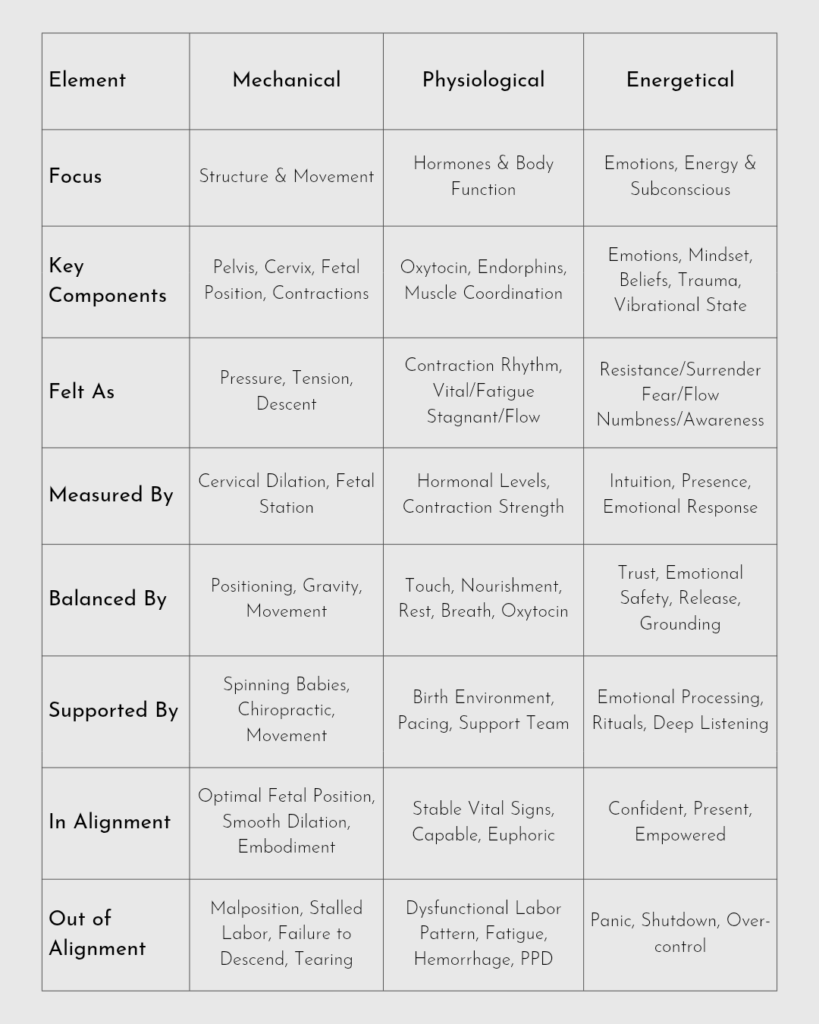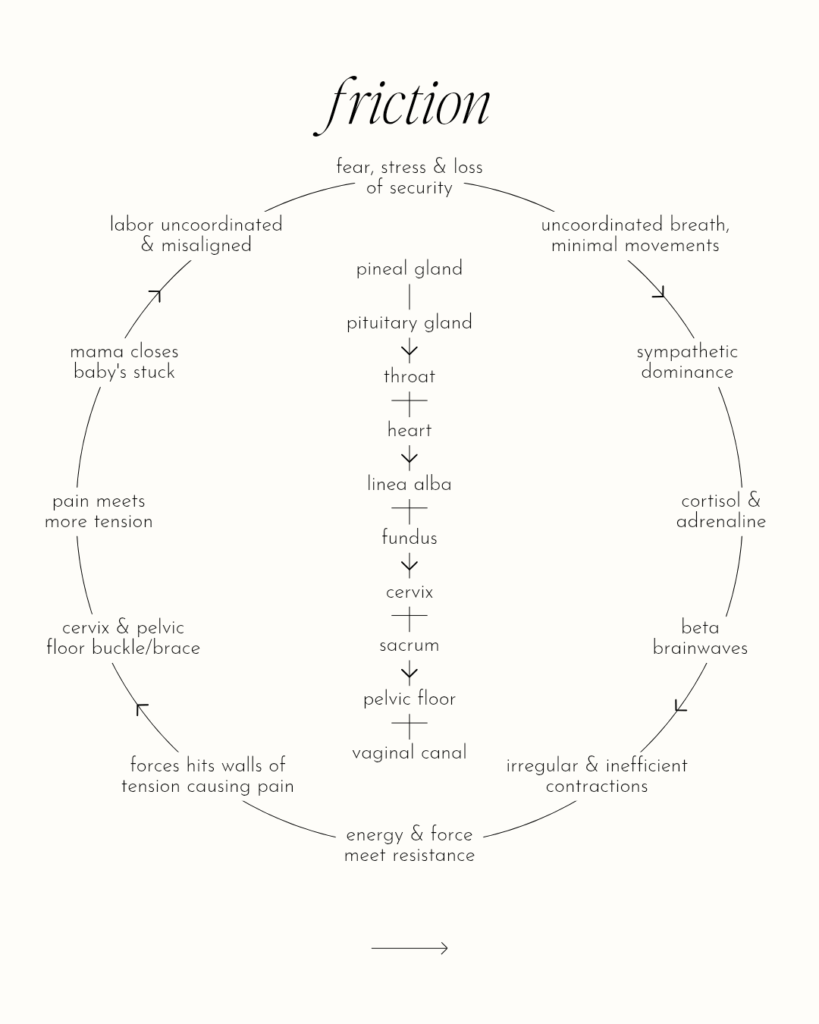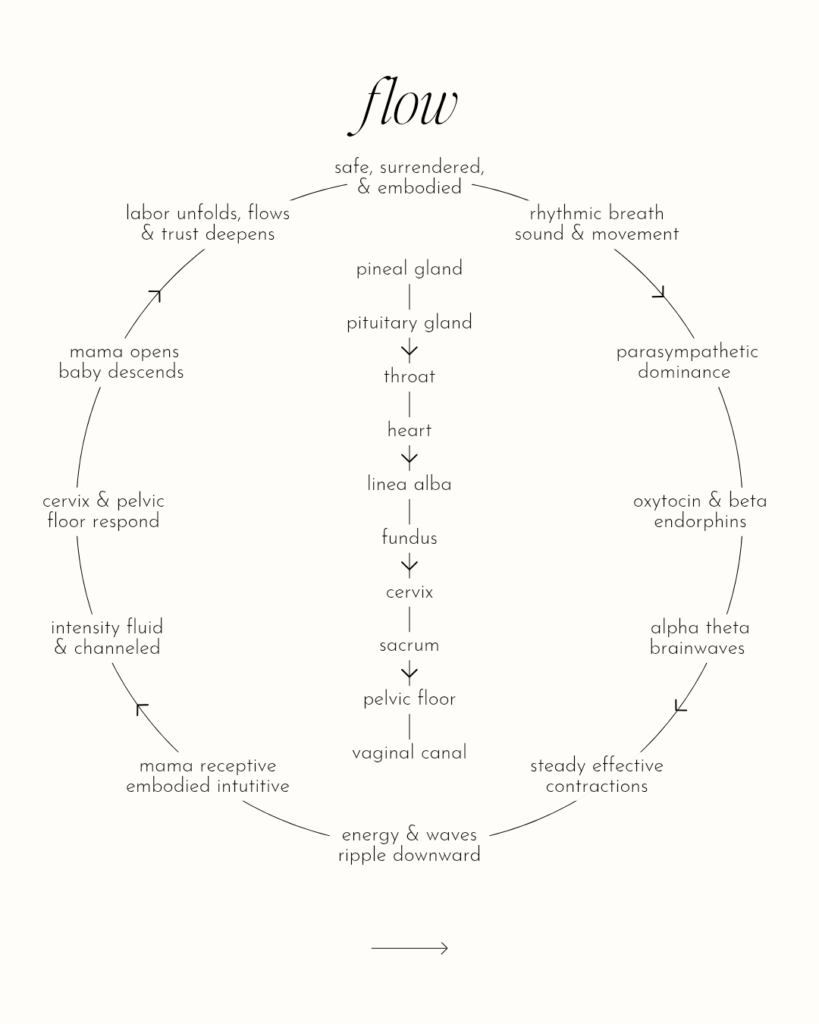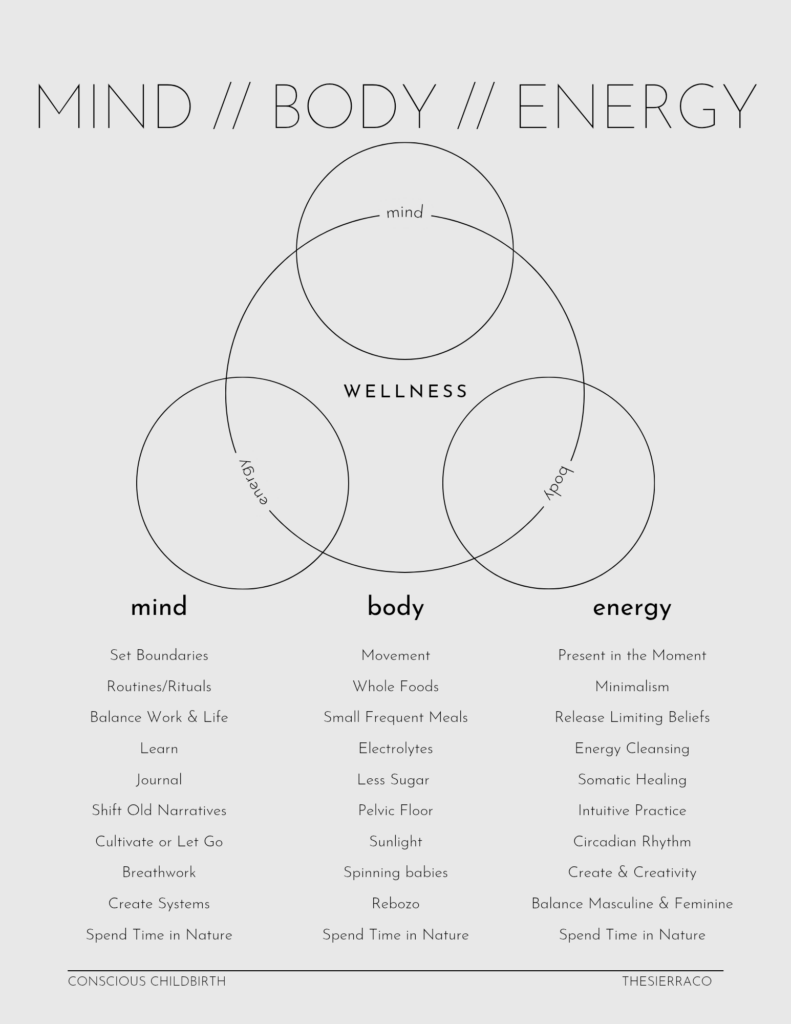the blog
Natural Birth & Female Health

highlights
Since losing the art and wisdom of birth, and with it a trust in the female body, our society has perpetuated the narrative that birth is dangerous and to be feared.
•fear, in the presence of old thought patterns, can trigger the sympathetic nervous system as well as the instinct for safety and survival. It activates hormones like cortisol and adrenaline making labor difficult.
•this biochemical cascade disrupts the body’s natural rhythm
•keeps us from experiencing the delicious hormones like oxytocin and endorphins that off natural pain relief, smooth birth and breastfeeding
•prevents us from dropping into an altered consciousness [between the realms]
•affects our ability to think clearly or access our intuitive guidance.
•With education, reflection, and tools we can transition to the safe, connected and grounded state of our parasympathetic nervous system where hormones like oxytocin and serotonin are regulated in favor of birth and bliss.
•In this state, we can honor the initial instinct of our primal body while leaning into our intuition for guidance based on physiologic truth and embodied wisdom.
You were drawn to this post because you are on a path of preparation for the childbirthing year. You seek to reframe your perspectives around birth through a deeper understanding of it’s dimensions, to shed light on the unknown elements, to discover how to channel emotions like fear, and ways to labor more in alignment with your mind, body and energetic design.
You are not alone, mama.
your birth landscape: the 3 dimensions of birth
Labor doesn’t just happen in the body, it also unfolds through physiological, mechanical, and energetic dimensions.
•Mind/Physiology initiates and coordinates the process
•Body/Mechanical responds by opening and moving.
•Energy/Energetic & Emotional set the tone—either constriction or expansion, fear or flow.
Each one is distinct and yet all three are interwoven, working together to support the flow and unfolding of a birth that becomes more intuitive, embodied, and safe.
Fear in labor can ripple through all three dimensions—emotional, physiological, and mechanical—disrupting the body’s natural rhythm and initiating a cycle of friction in birth.

how does fear affect labor and birth?
energetically
fear triggers a sense of danger or overwhelm, causing resistance and dissociation. It is energetically depleting, closing our centers, and keeping our brainwaves from shifting into trance, subconscious and transcending alpha and theta waves.
What is meant to be a spiral of energy moving through you in waves, is now a fragmented and blunt irregular wave form.
As this energy meets resistance it doesn’t descend smoothly, circumferentially, but instead, it ricochets and transfers that now directionless momentum into the body.
The energy is transmuted into shock waves that amplify discomforts, create dis-order in the body, and prevent the steady progression of labor.
It can stop the flow of energy within the body, close the portal in the womb space and alter the frequency of mama’s aura.
Physiologically
this activates the sympathetic nervous system, a state of flight, freeze or fight. Heart rate and blood pressure increase with the body’s oxygen demand. We need more oxygen in this state yet, we tend to breath fast and shallow when in the face of danger, lowering our ability to oxygenate our vital organs.
the placenta receives less oxygen and baby begins to mirror the physiologic and energetic experience of mama.
When we are afraid, anxious or under stress without the most aligned tools to manage our emotions or energy, our body’s release cortisol and adrenaline l. These hormones swell in the body, our mental clarity becomes a haze of overwhelm
increasing cortisol and adrenaline while suppressing natural pain relief and oxytocin.
This can weaken or stall contractions, increase the risk of interventions, hemorrhage, tearing and fetal distress.
Mechanically
fear creates muscle tension, especiallly in the jaw, shoulders, and pelvic floor, affecting baby’s position and ability to descend leading to complications like muscle fatigue, maternal exhaustion, hemorrhage.
Often times fear, without awareness, education and coping tools, can lead to the very thing we re afraid of by pulling us out of alignment, and out of flow, with our natural rhythm.
Because the three aspects of birth affect one another, energetic states like fear and flow can create a positive feedback loop: a cycle that feeds into itself, perpetuating a cause-and-effect loop.
The fear-tension-pain cycle slows labor and intensifies suffering, leading to more fear, stress & anxiety.
The body closes, the energy momentum disrupts, and labor slows to protect you and baby until the misalignments are adjusted.

channeling our energy & emotions from a safe place
This positive feedback loop reinforces confidence as well as presence while stimulating natural pain relief helping labor unfold more naturally and effectively.
In contrast, when a person feels safe and supported, they enter the flow cycle: emotional trust enables surrender and energetic flow. This opens and softens the body and supports oxytocin release leading to strong, regular and efficient contractions as well as smoother mechanical progress.
The flow-surrender-pleasure cycle supports a smooth and possibly euphoric and embodied experience for mama, keeps baby oxygenated and safe, and reduces the risk of interventions, unwanted outcomes and birth trauma.

the source of fear in birth
Fear of birth is central to the birth narrative our society shares with women.
It is common to have strong emotions, like fear, about the unknown, and/or unanchored feelings like anxiety, uncertainty, and a loss in confidence about what lies ahead.
Women often express these common concerns, fears, and hesitations about birth:
long or painful labor
tearing in birth
non emergent challenges
emergencies
We’ve been conditioned to fear the birth process and view it as a medical emergency, with a high potential for complications and unwanted outcomes.
Complications are less likely to occur when we support the natural biological process of birth.
Shedding light on the mysteries of birth can ease fears, highlight your ability to birth safely, as nature designed, and elevate your confidence.
That said, the focus is not necessarily to avoid or ignore our feelings, as that can block our energy. They are instincts that speak to us.
The intention is to understand the source of our feelings, to hold an awareness for them without slipping into a heightened state of stress, and to work through them with the most aligned tools.
learning about how fear affects the birth path and how to navigate feelings will serve you in birth. We can’t always control what feelings may come up, but we can prepare how we channel that energy.
how to ease your fears surrounding birth

1 education // getting informed
The unknown can be scary. As women we have the potential to hold multi-linear timelines in our minds, an ability to anticipate every possible scenario. But this can easily spiral into overanalyzing hypotheticals.
Getting informed grounds us in the realm of concrete possibilities. It reveals the true birthing landscape and it’s realities so we can leave behind the ‘what-ifs’ and ‘i heard that’…
One of the most common things I hear from families is “we didn’t know what we didn’t know”.
Lets change that.
Lean into resources that help you better understand birth dynamics at a foundational level.
RESOURCES: A collection of free guides, books, podcasts, videos and social channels to explore.
Find educational resources that you’re most aligned with that will give you insights or tools to prevent or resolve the things you’re concerned about happening in labor.
RELATED: 3 Elements to Support a Smooth Labor and Birth
Discover that birth is NOT an emergency requiring medical attention and that the things you’re most afraid of can be avoided with a deep understanding of birth and tools to navigate it.
Evidence based education helps integrate birth knowledge at a cognitive level from which we can begin to do the inner work needed to believe it at a cellular level and eventually rewrite our neuropathways that hold old thoughts, beliefs and traumas.
2 reflection // clarifying your feels
Clarify your fears, explore the root of your fears and take a moment to honor your emotions.
What are you afraid of? Do you trust >>
- Yourself, your ability to call in your power, your ability to overcome any challenges that meet your path
- Birth as a natural and safe process
- Your team as the people that are meant to support you
- Your body and its ability to communicate with you about what feels aligned and what does not
Create space for deep thought, open mindedness and curiosity as you reflect. You can dedicate a journal, spend time in nature or call in your community to help you work through your fear or hesitation around birth.
Talk to your birth team. A holistic practitioner will hold space for you, offer insights or tools, refer you to other resources, help you in labor to stay grounded and prevent or resolve the things you’re concerned about as birth unfolds.
if you’re planning to freebirth you can always reach out to birthworkers that offer guidance leading up to sovereign birth.
LETS CONNECT: I would be honored to answer questions or help you prepare for your autonomous birth.
3 empowerment // cultivate tools
Empowerment is where intuition and education meet. You can equip yourself with knowledge and tools to navigate emotions like fear.
For some women it is enough to learn about birth, for others knowing facts may not be enough to overcome hypotheticals that cause anxiety and fear. Or they may wish to learn practical exercises to ground their nervous system and channel their feelings.
This is where tools come in.
Cultivating tools in pregnancy can help you stay grounded in truth and present in the moment.
Discernment: practice discerning between intuitional sense and insecurity/fear/worry
Breathwork: grounds and calms the central nervous system
Mantras: anchoring yourself in your known truth
Sound technology: vibrations created through singing, chanting, humming, and even rhythmic movements stimulate the parasympathetic nervous system, relieve pain and offer a stability and securing.
Touch: connection with others stimulates oxytocin and feels of security and strength
Encouragement: bringing awareness back to the things we can control while letting go of what we can’t. Being reminded that we are capable, powerful, safe and in a temporary transition can help us transmute emotions into supportive ones.
These are some of the tools used in labor to channel fearful energy.
4 intention // define your birth vision
Choose you model of care, your birth team and your birth environment with intention.
Make sure your birth team’s approach supports natural birth, not just mechanically but physiologic ally and energetically.
5 returning // birth narrative and language
Shifting the narrative and the language surrounding birth is a powerful way of reconnecting to our inner knowing that birth is natural and safe.
Language shapes our reality, it can rewrite or reinforce our beliefs, affecting how we think and feel when we enter the birth space.
The medical model and society has perpetuate a narrative that birth is dangerous, emergent and requires medical management. This and other misconceptions about birth instills deep fears.
Fear based practices, fear based decisions and fearful energy leads to the very complications and unwanted outcomes that we’re afraid of and wanting to prevent.
We come from a long lineage of women that CAN birth. Our bodies-physical, mental and emotional-are designed to support healthy pregnancies, smooth labors and safe births.
Connect with like minded women, curate resources, and choose a birth team that supports the natural birth narrative.
6 embodiment // prepare mind / body / energy
Investing time in pregnancy to full body/ies wellness helps our physical, mental and energetic bodies which reduces the risk of complications.
By focusing on holistic health we lay a foundation for birth to unfold smoothly, as it is meant to, prepare ourselves for navigating challenges in labor if they do arise. This also prepares us for parenthood as we bring with us what we learn, the lifestyle adjustments we make and the tools we cultivate into our new identity as parents.
As we ve learned-the physical, hormonal and energetic aspects in labor are interwoven making birth a multi-dimensional process involving the body, the biology, and the unseen elements of emotions and energy.
Supporting just physical body can have positive impacts but it is not the whole picture. It’s important to make time for our energetic and mental bodies too.

a review
uno-shed light on the mysteries of birth
Related: 3 Elements to Encourage a Natural, Smooth and Safe Labor
dos-reflect on how you feel about birth
Related: how to use intentional breathwork in birth
tres-cultivate the most aligned tools to navigate your energy
cuatro-clarify your birth vision
Download your free guide and template to clarifying your birth vision
cinco-shift the narrative and reclaim language surrounding birth
seis-focus on mind, body, energy wellness